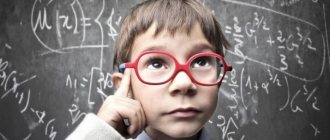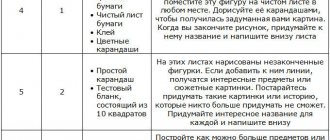Thinking and speech are what distinguishes a person from an animal. Verbal and logical thinking is inherent only to man; it is formed in the process of his development and maturation.
Thinking is the highest level of cognition, the process of recreating the reality around us. Thinking is often identified with the mind. This is not entirely true.
If the mind is the ability to think and find solutions to various problems, then thinking is a prerequisite of the mind , a tool of a thinking person, working with meanings.
Thinking, speech and logic
Human thinking is verbal, it is formed in the process of communication and its formation is possible only through the joint activity of people. All people are different, some people find it easier to think if they see or imagine objects - this is visual thinking. Others operate with abstract structures (words) - this is what distinguishes verbal logical thinking.
Speech is a form of communication between people using language constructs created according to historically established rules, the highest mental function of a person. Speech formulates thoughts using words and presupposes their understanding and perception by another person.
Logic literally means reasoning, speech, thought. Logic is a science that teaches us to draw conclusions indirectly, that is, not from sensory experience, but from previously acquired knowledge.
Causes
The prerequisites for such a speech disorder usually arise during the development of the fetus, during the birth process and the first years of the baby’s life (65-85%). In this way, it is similar to cerebral palsy, and also accompanies it, and the more severe the motor disorders with such a serious pathology, the more pronounced the dysarthria.
Perinatal reasons:
- severe toxicosis in the expectant mother;
- Rhesus conflict;
- the presence of a chronic disease in a woman in labor;
- fetal hypoxia;
- intrauterine asphyxia;
- difficult childbirth;
- prematurity;
- kernicterus in a newborn.
Other factors:
- intoxication of the body;
- hydrocephalus;
- encephalitis and meningitis;
- traumatic brain injury;
- purulent otitis.
In adults, dysarthria can occur as a result of head trauma, stroke, neurosurgery, or due to a brain tumor.
This pathology, in addition to cerebral palsy, can occur in those suffering from Parkinson’s disease, mental retardation, multiple sclerosis, myasthenia gravis, neurosyphilis, etc.
Types of logical thinking
During the preschool period, all cognitive processes are formed , among which the most important place belongs to the development and formation of thought and speech.
- Visually effective things are formed in early childhood, from about one and a half years old. The child's first generalizations are associated with the same actions performed with similar objects. Suppose a child sees a bottle of milk - now he will be fed. In adult life, it is used, for example, in experiments whose results cannot be predicted in advance.
- Visual imagery usually manifests itself most clearly in children 4-6 years old. It operates with images and involves visualizing the situation. Most often, direct contact with the object is not required, but it is necessary to clearly imagine it. If you ask a child what a dog is, he will point to a picture or a puppy sitting next to him, rather than listing the number of paws and ears of the animal. Adults use it to describe concepts that they cannot see - the structure of a molecule, the earth's core.
- Verbal logical usually begins to develop in older preschool and primary school age, continuing to form and develop throughout life. This is the ability to think through reasoning, carried out using language and logical operations with concepts, the latest stage in the evolution of thinking.
An example is the coin example . If it is visually effective, a person will see a fallen coin and realize that he can take it in his hand or put it in his mouth, since it will fit there. If it is visually figurative, he will throw it up and see what comes up, heads or tails. With the verbal-logical one, he will begin to argue about whether it can hang in the air or stand on its edge, and if not, then why.
Symptoms
A person with dysarthria speaks incomprehensibly, unclearly, and has what is called “porridge in his mouth.”
This happens due to the poor relationship (innervation) of the muscles of the vocal folds, respiratory muscles, tongue, soft palate, lips - everything without which speech reproduction is impossible. Articulatory motor skills can be different, and this is due to the condition of the muscles:
- their muscle spasm is accompanied by tension in the muscles of the tongue, neck and lips. The latter are tightly compressed, which limits the pronunciation of sounds;
- with hypotension (low tone), the mouth remains half-open, since the lips are not closed, saliva flows from it. The tongue, without moving, is at the bottom of the mouth. Paresis (relaxation) of the soft palate leads to speech “in the nose”;
- Dystonia increases muscle tone when trying to speak.
Sound pronunciation depends on the degree of dysarthria. Thus, erased is characterized by weak distortions and some blurriness, and 2 and 3 – speech is slurred, very slow, unemotional, sounds in which are missed or incorrectly pronounced. Total paralysis of the muscles involved in speech is the most severe degree, the 4th, in which it is generally impossible to say anything.
Sounds with dysarthria are difficult to articulate, this applies to both consonants and vowels. Whistling and hissing sounds are pronounced between the teeth or sideways, hard sounds are softened, ringing sounds are muffled.
Speech breathing is impaired in various types of pathology - it is rapid and even intermittent, shortened during exhalation. The voice is weak, fading, dull, nasalized. Speech is monotonous, there is no modulation.
Verbal logical thinking
Thanks to verbal thinking, we operate with such concepts as honor, conscience, love, value. After all, we cannot visualize them - these are verbal constructions , perhaps everyone puts their own meaning into them.
As a result of verbal logical thinking, a person can operate with the most abstract concepts without completely breaking away from sensory experience. With its help, we look for and find patterns, generalize previously gained experience - both sensory and visual.
Verbal logical thinking does not descend upon us overnight; it is gradually formed throughout life, in the process of learning and gaining personal experience. Some people master it to a greater extent than others; we call them talents or geniuses, while others master it less.
Special simulators
There is a direct and clear relationship between a person’s vocabulary and his income level. A richer vocabulary means a better income. A person who has the ability to create an accurate and vivid description (orally or in writing) depends on the success of selling any product or idea. This skill, coupled with analytical abilities, makes a person an indispensable professional in any field of activity.
A ready-made key to mastering these skills is Vikium simulators and courses. For example, the intensive “Development of Thinking” will allow you to learn how to make the right decisions with lightning speed, gain the upper hand in verbal debate, and master the art of competent persuasion and logical conclusions. Such skills are necessary for both performers and managers at any level.
Operations of verbal logical thinking
In the learning process, we operate with certain concepts .
- Analysis is a transition from the general to the specific, the division of an object into components, the differentiation of various properties, elements, and connections in it.
- Synthesis is a transition from the particular to the general. Combining the constituent parts into a single whole.
- Comparison is a comparison of phenomena and objects, isolating their differences and similarities with each other.
- Generalization is the unification of phenomena and objects according to significant characteristics, one or more.
- Classification – grouping according to characteristics. In contrast to generalization, which is based on significant features, classification recognizes desirable but unimportant features as a basis, for example, drink preference.
Differences
Psychologists believe that people with nonverbal thinking have difficulty coping with even the simplest tasks presented in symbolic form. Individuals with a verbal type of mental activity find it difficult to achieve tasks that require operating with visual images. But they have the ability to learn foreign languages.
People with non-verbal thinking have inclinations in the field of drawing and painting. They are well versed in diagrams and drawings and can create various designs. With visual thinking, clear images of objects and phenomena emerge in a person’s brain structures; with a verbal thought process, abstract symbolic structures emerge.
Thinking is formed in the process of communicating with other people. Both types of thinking facilitate the transfer of information from one person to another. Nonverbal communication is carried out through body language, facial expressions and movements. Verbal speech forms are created through linguistic constructions.
Speech activity is carried out orally and in writing in the form of a monologue or dialogue
To implement it, it is important to study the grammatical and syntactic features of the language, to master the lexical (vocabulary) composition
The importance of developing verbal logical thinking in children
It is necessary to develop verbal logical thinking in preschoolers because children will soon begin studying. From the first days they will study subjects based on logic , and unprepared children will have a very difficult time.
Undeveloped verbal logical thinking interferes with the assimilation of knowledge, leads to the inability to express one’s thoughts, and prevents the establishment of normal contacts with teachers and other children. This is why adaptation in our society is so difficult for the deaf and mute. They go to special schools, they are taught using special methods, they even have their own language.
To help your child, you can:
- ask him to retell cartoons;
- compose fairy tales with him;
- solve simple logic problems with him;
- solve riddles;
- ask him to explain the meaning of proverbs and sayings.
Forecast
The sooner the corrective pedagogical intervention begins, the faster and better the result will be. Its success depends on the professionalism of the specialist, the diligence of the little patient and the feasible help of his parents.
A child with erased dysarthria can master the skills of normal speech, speak correctly, accurately expressing his thoughts and so that those around him can understand him well. He can study in a general education institution quite successfully, but he will have to visit a speech therapist - at school, in a clinic or privately.
Verbal logical thinking in human life
Verbal logical thinking implies not only the ability to think logically, but also masterful command of words . It is precisely this that is involved in our communication with other people. After all, if a person knows something, but cannot convey it to others through speech, he becomes like a mute. If a person speaks beautifully, but is at odds with logic, he is as good as deaf.
It is to him that we owe all the discoveries that humanity has made during its existence. If a person cannot think logically, he will not discover anything. If he cannot convey his message to others, his discovery will die with him.
What is verbal ability?
Well-developed verbal abilities allow a person to master the language system. It includes various elements and rules for using and connecting these elements. The language system includes:
- phonetic side of speech;
- grammatical structure of speech;
- lexical side of speech;
- syntax.
The phonetic side of speech is the sound composition of the language.
Verbal abilities allow you to distinguish sounds by ear and determine the correctness of your pronunciation. In grammar, verbal abilities are manifested by correctly constructed utterances, the words in which are consistent, cases and prepositions are used correctly. In syntax - beautifully and correctly formed sentences that make up a coherent text. The vocabulary of a person with well-developed verbal abilities is usually rich. All of the above helps in the verbal side of communication, that is, communication that occurs using speech. Highly developed verbal thinking helps to convey your thoughts to your interlocutor, convince you that you are right, and establish dialogue and joint activities. With insufficient development of these abilities, the communication process is difficult (see Dysarthria in children). Only the non-verbal side of communication (facial expressions, pantomime and gestures) does not provide sufficient information. High-quality use of speech to convey information is necessary in the communication process.
General information about thinking style
In psychology, a thinking style is a system that has its own relatively constant core, structure and selectivity in relation to external influences. Each person uses a style that has developed over the course of his life, and he considers this style to be the most optimal for himself.
When making decisions, a person always uses a specific set of mental strategies. They have their advantages and disadvantages: they are useful in different situations and can lead to positive or negative consequences depending on how correctly a person uses them.
In life, most people, as a rule, use no more than two sets of strategies, practically without thinking that there are other strategies or styles of thinking with which they could become more flexible, adapt more quickly to changing living conditions, and solve problems better , interact more effectively with other people, etc.
The very concept of “thinking style” reflects one simple truth: people think differently about the same things. They apply their intellectual techniques, operations and skills, to which they are predisposed due to their personal characteristics, formed in childhood and developed throughout their lives until the present moment.
Some people are more successful and productive than others because they have multiple thinking styles. The rest turn out to be less successful and productive, because... “tied” to only one (maximum two) styles. However, any person has the opportunity to grow and “upgrade” themselves by developing their mind and mastering new strategies.
In addition, most people do not think at all about what style of thinking they use. And just understanding this could significantly improve their life and professional results. Knowing what the peculiarities of his thinking are, a person can select a suitable job and life’s work, develop his own strategies for making decisions and achieving goals, identify his weaknesses and work on his shortcomings.
And knowing what styles of thinking generally exist, a person will understand in what situation it is better to use one or another strategy, to solve what problems it is necessary to “switch” from one style to another. Understanding the features of different styles, it is much easier to master them and start operating in real life. That's why we want to introduce you to the five main thinking styles. To begin with, we suggest you watch a short video.
Mastering new things
Identify a new skill for yourself - something you don’t know how to do yet. For example, master speed reading or an unfamiliar language. Describe what resources you will need to develop it, with what frequency and under what conditions will you do this, according to what plan? In the case of speed reading, for example, courses and simulators of the same name from Vikium will be of great help. After going through them, you will be able to “devour” books, deeply understanding their content (this can be done even in a store, without leaving the rack!), prepare training and work presentations, reports, reports more quickly and productively, and also free up a huge amount of time for myself.
Have you written everything down? Now let's start implementing it!
Diagnosis of verbal and non-verbal intelligence
Verbal and nonverbal intelligence are diagnosed in different ways. There are differences in the tasks and the material on which these tasks are given. Diagnostics of verbal intelligence is carried out using tasks for comparison, analysis and synthesis of verbal material. In addition, the material was selected taking into account the age of the subject. Most often, G. Eysenck's verbal intelligence test is used to diagnose verbal intelligence.
To diagnose nonverbal intelligence, tasks based on visual material are used, without the use of speech. In test tasks, a person manipulates objects, composes a figure from individual elements, and compares visual material. To determine the level of development of non-verbal intelligence, “Kos cubes”, a test in the form of a Seguin form board, and Raven’s progressive matrices are used.
There are also tests whose tasks allow you to assess the level of development of both verbal and nonverbal thinking at the same time. This is, for example, the Wechsler intelligence test. Diagnostics in this case takes a fairly long period of time, about 1.5 - 2 hours.
Let's sum it up
Verbal and non-verbal thinking are interconnected. A reduced level of development of one of these types of thinking also affects the other type. For example, if the insufficient level of development of spatial thinking does not allow one to be well oriented in the size, shape and relationship of objects, speech development will also suffer. In this case, a person may confuse letters with similar images (see Dysarthria). Insufficient development of verbal thinking will affect the understanding of any type of information.
Attention!










